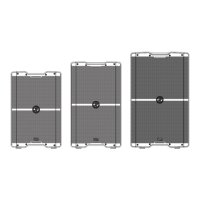SRM | V-Class High-Performance Powered Loudspeaker Series
12
SRM | V-Class High-Performance Powered Loudspeaker Series
SRM Mix Control™
The following list provides the high level navigation
items, in order, on the user interface and their
subsequent user controlled parameters.
The default screen is the mixer view, as seen below:
Mixer – This displays the I/O levels
and metering, EQ settings, HPF levels
and more. These may all be changed here.
Menu – The menu provides icon selectors
for all user-controllable functions with most
of these containing an array of sub-menus.
The menu is accessed by rotating the speaker
control knob clockwise until the menu icon
is illuminated in a can’t-miss DayGlo green;
then press again to open the menu.
We will go through each, how to get there and how
to change settings.
Afer a selection is made, the LCD screen will
revert back to the Mixer screen afer a short period
of (speaker control) inactivity. You yourself may
continue to be as active (or inactive)as you want.
Rotate the speaker control knob to navigate between
the selections and push the button to open and edit
the parameters.
Mixer
Delay
Mode
Bluetooth
Sub
Config
MIXER MODE SUB
DELAY
BT
Mixer
As mentioned earlier, the default screen is the mixer
view. And the default selection is the output level.
From here, simply rotate the speaker control knob
clockwise (louder) or counter-clockwise (quieter).
The top row selections change the levels of input
channels , 2 and BT and the Main output. Notice below
how each parameter illuminates as the speaker control
knob is rotated to the right from channel to 2,
Bluetooth (BT) and the Main output last.
In order to change the level, push the speaker
control knob when the desired channel is illuminated.
In the example below, notice how the channel 2 fader
has been moved to the –4 dB mark. Once the level
you desire has been dialed in, press the speaker
control knob again to return to the mixer screen.
The level control ranges are as follows:
• Channels and 2: – (o) to “U” (unity)
• Bluetooth: – (o) to “U” (unity)
• Main Output: – (o) to “U” (unity)

